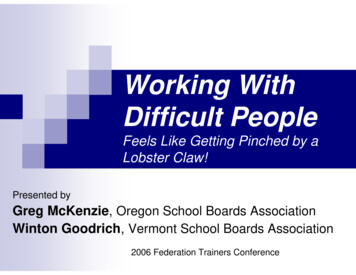
Transcription
Working WithDifficult PeopleFeels Like Getting Pinched by aLobster Claw!Presented byGreg McKenzie, Oregon School Boards AssociationWinton Goodrich, Vermont School Boards Association2006 Federation Trainers Conference
Coping With Difficult PeopleDr. Robert BramsonDealing With People You Can’t StandDr. Rick Brinkman & Dr. Rick Kirschner2006 NSBA Convention3
10 Most Unwanted List1. “Tank” Confrontational, pointed & angryThe ultimate in pushy behavior2. “Sniper” Rude comments, biting sarcasmAttempts to make you look foolish2006 NSBA Convention4
10 Most Unwanted List3. “Grenade” After initial calm, explodes intouncontrolled ranting & raving4. “Know-it-All” Has a low tolerance for correction andcontradiction2006 NSBA Convention5
10 Most Unwanted List5. “Think-They-Know-It-All” Attempt to fool some or all of the peoplemost of the timeReally an attempt to get attention6. “Yes Person” Say “yes” without thinking thingsthroughAn attempt to please people and avoidconfrontation2006 NSBA Convention6
10 Most Unwanted List7. “Maybe Person” Procrastinates in hope that a betterchoice will present itself8. “Nothing Person” No verbal feedbackNo non-verbal feedbackNothing2006 NSBA Convention7
10 Most Unwanted List9. “NO Person” Able to defeat big ideas with a singlesyllableDeadly to morale10. “Whiner” Feel overwhelmed by an unfair worldMisery loves company and they bringtheir problems to you2006 NSBA Convention8
Four ChoicesThese are the difficult people thatmost people cannot stand workingwith, talking to, or dealing with.You have four options:2006 NSBA Convention9
1st Choice1. Stay and do nothing Leads to suffering and complaining tosomeone who can do nothing about itCan be dangerous because frustration buildsand gets worse over timeComplaining to people who can do nothingtends to lower morale2006 NSBA Convention10
2nd Choice2. Vote with your feet Not all situations are resolvable and some arejust not worth resolvingIf everything you say makes matters worse,remember, discretion is the better part of valorEleanor Roosevelt said, “You’re nobody’svictim without your permission.”2006 NSBA Convention11
2006 NSBA Convention12
3rd Choice3. Change your attitude about yourfellow board members Learn to: see them differently, listen to themdifferently and feel differently around themChange your attitude to set you free from yourreaction to the problem you see in theirbehavior2006 NSBA Convention13
4th Choice4. Change your behavior Change the way you deal with people and theywill need to learn new ways to deal with youOnce you know what needs to be done andhow to do, you will be able to take charge of anunpleasant situation and redirect its result2006 NSBA Convention14
Observations About PeoplePeople: Are creatures of habit Behave in certain ways to meet their needsObservations: How we communicate is a habit When our needs are not met, we react Stronger the need, the stronger the reaction2006 NSBA Convention15
Lens of UnderstandingEverybody responds to different situationspredictably during times of challenge, difficulty,or stress.People tend to move outside their behaviorcomfort zone and become either more passiveor more aggressive than normal.2006 NSBA Convention16
PatternsFor a better understanding of a person’spredictable behavior during times of duress, lookfor patterns of behavior to determine whatpeople usually focus their attention on in a givensituation. People vs. TaskAssertive vs. Cooperative2006 NSBA Convention17
People FocusAssertiveNormal ZoneCooperativeTask Focus2006 NSBA Convention18
People FocusYES PersonMAYBE PersonNormal ZoneCooperativeTANKWHINERSNIPERNO PersonNOTHING PersonKNOW-IT-ALLTask Focus2006 NSBA Convention19
Dangerous Assumptions “They are just like me.”“They should act the way I expect them toact.”“I am right. They are wrong.”“My view is the only valid view.”“I know what they meant by that . . .”“Their intention is obvious.”2006 NSBA Convention20
Table Work Complete Communications Style choicesLocate communication quadrantSeparate into groupsPose questions to groups2006 NSBA Convention21
COMMUNICATION PROFILE K2006 NSBA Convention22
COMMUNICATION PROFILE K2006 NSBA Convention23
Question #1List 5-8 words that describeyour group’s behavior style.2006 NSBA Convention24
The Nail Game2006 NSBA Convention25
ObserversReport
Behavior Has a Purpose Every behavior has an intent orpurpose and that intent is to fulfill.People do what they do based onwhat seems to be most important forany given moment.Four “general intents” determinehow people will behave in any givensituation.2006 NSBA Convention27
Four General Intents1. Get the job done.2. Get the job done right.3. Get along with people.4. Get appreciation from people.2006 NSBA Convention28
Get it doneGet it rightGet alongAppreciation2006 NSBA ConventionObservationControllingPerfectionistSeeks ApprovalSeeks Attention29
THE FOUR COMMUNICATION STYLESPeople k Focus2006 NSBA ConventionCooperative30
Which Style?“Just do it. What’s next on the agenda?”(Task/Aggressive - Driver)“I think I’ll double check your figures.”(Task/Passive - Analytical)“Come see the award I won today.”(People/Aggressive - Expressive)“Let me help you with your project.”(People/Passive - Amiable)2006 NSBA Convention31
SNIPERGRENADETHINK-THEYKNOW-IT-ALLPeopleFocusYES PersonMAYBE PersonGetAppreciatedAssertiveNOTHINGGet AlongNormal ZoneGet It DoneCooperativeGet It RightWHINERTANKNO PersonSNIPERKNOW-IT-ALLNOTHING PersonTask Focus2006 NSBA Convention32
Notes1. All of these intents have a time and placein our lives.2. One quick indicator of a person’s intent istheir communication style.3. When people have shared intent orpriorities, conflict is unlikely.4. As intent changes so does behavior.2006 NSBA Convention33
Inherent Conflict in Decision MakingRolePressuresCommunity pressuresvs. professional staffpressuresDifferences inbelief, philosophy,political orientationDifferences inPerceptionsValueDifferencesNew board member vs.the establishedmember, city vs. ruralBoardDecisionsDifferences inPosition orStatusViewing factsdifferentlyDifferentGoalsConserving resourcesvs. expanding service2006 NSBA Convention34
Know Your Teammates Not understanding the intent andcommunication style of team membersamplifies the inherent conflicts alreadycomplicating board decision-making.Not understanding why groups aredysfunctional in part or whole furthercomplicates effective decision-making.2006 NSBA Convention35
Why Teams UnderachieveThe Five Dysfunctions of a Team-- By Pat Lencioni2006 NSBA Convention36
Absence ofTRUST2006 NSBA Convention37
Teams with an absence of trust . . . Conceal weaknesses and mistakes from each otherHesitate to ask for help or provide constructivefeedbackHesitate to offer help outside their own areas ofresponsibilityJump to conclusions about the intentions of otherswithout attempting to clarify themFail to tap into one another’s skills and experiencesWaste time and energy managing their behaviors foreffectHold grudgesDread meetings and avoid spending time together2006 NSBA Convention38
Overcoming Lack of TrustVulnerability-based trust requires sharedexperiences over time, multiple instances offollow-through and credibility, and an indepth understanding of the uniqueattributes of team members. Personal Histories Exercise Team Effectiveness Exercise Personality and Behavioral Preference Profiles Spending social time together2006 NSBA Convention39
Fear ofCONFLICTAbsence ofTRUST2006 NSBA Convention40
Teams that fear conflict Have boring meetingsCreate environments where back-channelpolitics and personal attacks thriveIgnore controversial topics that are criticalto team successFail to tap into all the opinions andperspectives of team membersWaste time and energy with posturing andinterpersonal risk management2006 NSBA Convention41
Overcoming Fear of ConflictThe first step is acknowledging that conflict isproductive. MiningReal Time PermissionPersonality ProfilingThe second step is always debate “issues” notpersonalities.2006 NSBA Convention42
Lack ofCOMMITMENTFear ofCONFLICTAbsence ofTRUST2006 NSBA Convention43
A team that fails to commit Creates ambiguity among the team aboutdirection and prioritiesWatches windows of opportunity close due toexcessive analysis and unnecessary delayBreeds lack of confidence and fear of failureRevisits discussions and decisions again andagainEncourages second-guessing among teammembers2006 NSBA Convention44
Overcoming lack of commitment Discuss what needs to be achieved up frontClarify the worst-case scenario for a decisionyou are struggling to make.Engage in substantial discussion. The quality ofthe decision is usually better than expected.Review the key decisions made during themeeting, and agree on what needs to becommunicated to other constituencies aboutthose decisions.2006 NSBA Convention45
Involvement vs. Commitment Breakfast Food AnalogyChicken involved with breakfastPig is TOTALLY committed!2006 NSBA Convention46
Avoidance ofACCOUNTABILITYLack ofCOMMITMENTFear ofCONFLICTAbsence ofTRUST2006 NSBA Convention47
A team that avoids accountability Creates resentment among team memberswho have different standards of performanceEncourages mediocrityMisses deadlines and key deliverablesPlaces an undue burden on the team leaderas the sole source of discipline.2006 NSBA Convention48
Overcoming Absence of AccountabilityThe key to overcoming this dysfunction isadhering to a few classic management toolsthat are as effective as they are simple.Publication of Goals & Standards - Clarifypublicly exactly what the team needs toachieve, who needs to deliver what, andhow everyone must behave in order tosucceed.2006 NSBA Convention49
Inattention toRESULTSAvoidance ofACCOUNTABILITYLack ofCOMMITMENTFear ofCONFLICTAbsence ofTRUST2006 NSBA Convention50
A team that is not focused on results Stagnates or fails to growLoses achievement-oriented employees andteam membersEncourages team members to focus on theirown careers and individual goalsIs easily distracted2006 NSBA Convention51
Overcoming Inattention to Results Public Declaration of Results – Committingpublicly to specific results is more likely tocreate a passionate, even desperate desireto achieve those results. Teams whose goalis, “We’ll do our best,” are subtly, if notpurposefully, preparing themselves for failureResults-Based Rewards – Tie the team’srewards to the achievement of specificoutcomes.2006 NSBA Convention52
Inattention toRESULTSAvoidance ofACCOUNTABILITYLack ofCOMMITMENTFear ofCONFLICTAbsence ofTRUST2006 NSBA Convention53
Easy Steps Just as certainly some people bring out thebest in you, some people bring out the worstin you.There are effective learnable strategies forbuilding better teamwork and overcominggroup dysfunctions.2006 NSBA Convention54
Listening Skills Exercise Divide the group into pairsSelect one person as the speakerSelect one person as the listenerBrief each group separatelyOne minute speaking exerciseSwitch Speaker/Listener2006 NSBA Convention55
Listening Exercise Debrief We communicate our interest whilelistening by:Verbal responsesBody language2006 NSBA Convention56
’sClosing Remarks OnResiliency 2006 NSBA Convention57
Listening SkillsFor Eye contact Focus on points of agreement Not judgmental Attentive body language No interruptions Repeat some words of speaker2006 NSBA Convention58
Listening SkillsAgainst Inattentive body language Verbal fillers No eye contact Distractions Kidnap their story Constant interruptions2006 NSBA Convention59
Listening in 3 ChannelsVERBAL - Actual words usedVOCAL - Tone, inflection, volume,speed, tempo, pitchNON-VERBAL - Body language2006 NSBA Convention60
Listening in 3 ChannelsVERBAL – Actual words used(7%)VOCAL - Tone, inflection, volume,speed, tempo, pitch(38%)NON-VERBAL - Body language(55%)2006 NSBA Convention61
Blending Any behavior by which you reduce thedifferences between youResult is to increase rapportAutomatic when people share a commonvision, care about each otherNo one cooperates with someone whoseems to be against them2006 NSBA Convention62
Blending Strategies Mirror each other’s body posture, facialexpressions and degree of animationBlend with the speaker’s voice volume andspeed (**anger exception**)Ask clarifying questionsIdentify what you think the speaker reallywants2006 NSBA Convention63
Blending Strategies Listening “for” while the difficult personvents, blows off steam, whines orcomplainsRepeat some of the actual words theother person is usingSummarize what you have heardCheck for understanding2006 NSBA Convention64
Redirecting Any behavior by which you use therapport from “blending” to change thedirection of the interaction“Redirecting” always follows blendingwhether listening to understand orspeaking to be understood2006 NSBA Convention65
Tips We get along better with people when theemphasis is on our similaritiesSuccess in communication depends onfinding common groundReducing differences is vital in dealingwith people who cause you difficultyWhen we communicate better – teamsfunction better2006 NSBA Convention66
Communicate ChallengeYour goal: Communicate to be understoodAction Plan:1.Monitor your voice’s tone, pitch,volume, pace, etc.2.Be positive about your response3.Tactfully interrupt4.Ask clarifying questions5.Be ready to listen attentively6.Blend and Redirect2006 NSBA Convention67
AttitudeLife is 10% what happens to meand 90% how I react to it!2006 NSBA Convention69
2006 NSBA Convention70
For More Information ContactOregon School Boards AssociationGreg McKenzie - gmckenzie@osba.orgVermont School Boards AssociationWinton Goodrich – wgoodrich@vtvsba.org2006 NSBA Convention71
Dealing With People You Can’t Stand Dr. Rick Brinkman & Dr. Rick Kirschner. 2006 NSBA Convention 4 10 Most Unwanted List 1.










